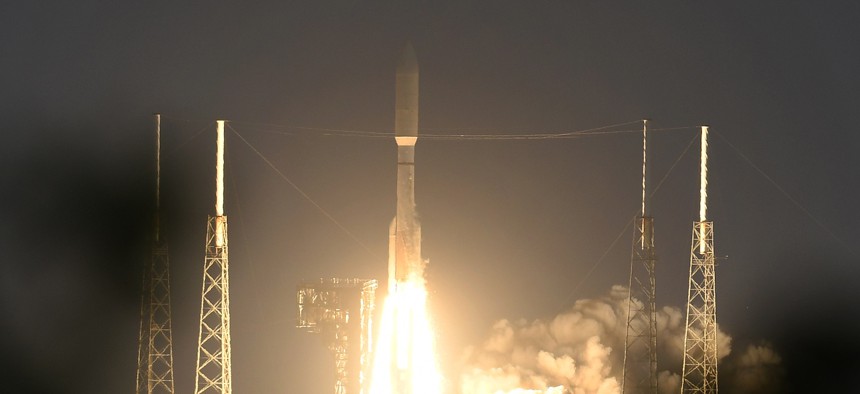
In this 2020 photo, a United Launch Alliance Atlas V rocket carrying a classified payload for the National Reconnaissance Office lifts off from Cape Canaveral Air Force Station, Fla. Paul Hennessy/SOPA Images/LightRocket via Getty Images
US offers rare preview of upcoming spy-satellite launch
Officials talked about Tuesday’s launch of NROL-107 in a bid to “deter the adversary.”
A Tuesday launch will aim to put highly secret object-tracking satellites into geosynchronous orbit, U.S. officials said in a press conference about an upcoming National Reconnaissance Office mission.
The launch, which will use United Launch Alliance’s Atlas 5 rocket, is part of the Space Force/NRO SILENTBARKER/NROL-107 mission.
The NRO’s missions typically remain highly classified, as the office operates the Defense Department’s spy satellites. However, the Pentagon is now being more open about its missions to deter adversaries, said Lt. Gen. Michael Guetlein, who leads Space Systems Command.
“A huge element of deterrence is the ability for the adversary to know what we can and cannot see, so we actually want our competitors to know that we have eyes in GEO and we can see what's happening in GEO,” Guetlein told reporters Monday.
The Defense Department is making an effort with this mission to be “more transparent,” said NRO Director Chris Scolese.
“We want to let people know, to some extent, what our capabilities are, and this is one capability that if you think about it, has great value beyond just national security,” Scolese said.
There are “multiple payloads” on tomorrow's launch, but officials wouldn’t say how many. They’re expecting a total of two launches for the SILENTBARKER mission but that could increase, Scolese said. SILENTBARKER will reach full operational capability in 2026.
The satellites will give the U.S. “unprecedented coverage of what's going on in the GEO belt so that we understand the intentions of other countries to see what they're doing in the GEO belt, to see if there's any indications of threats or if it's just normal,” he said.
Scolese described the program as a “watchdog” that will allow the Space Force and NRO to have a much better understanding of what's going on in GEO.
“We also want to know if there is something going on that is unexpected, or shouldn't be going on that could potentially represent a threat to a high-value asset, either ours or one of our allies,” he said.
Space Command has been vocal about its need for dynamic space operations—the ability for satellites to move around outside of a specific orbital position. Scolese said this new capability will give the U.S. the eyes to decide if and when it needs to move its assets in space.
“What SILENTBARKER is going to do is provide the indications and warnings so it can inform decisions about what we do or don't need to do in terms of maneuver or awareness. So it's a great increase in our understanding of what we'll be able to do and will greatly improve our ability to determine future courses of action,” Scolese said.
Following SILENTBARKER, there is one remaining National Security Space Launch Atlas 5 launch, which will also lift off from Cape Canaveral.
ULA will replace the Atlas 5 with its new heavy-lift rocket called Vulcan, which the company aims to fly by the end of the year, ULA CEO Tory Bruno said. Vulcan will deliver “more capabilities” than Atlas 5, Bruno told reporters Monday.
Atlas 5 has been flying missions that were originally supposed to be flown by Vulcan, which has been behind schedule for years due to delays in developing Vulcan’s main engine, BE-4—supplied by Jeff Bezos’s Blue Origin.



